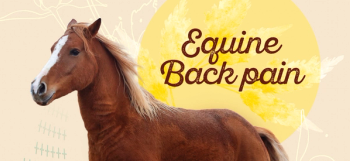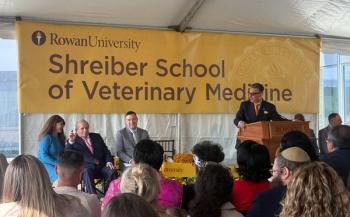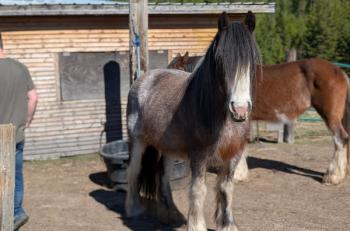
Equine reproduction: Q&A with an expert
Lexington, Ky. - What are some of the cutting-edge techniques to improve equine fertility and reproduction?
Lexington, Ky. — What are some of the cutting-edge techniques to improve equine fertility and reproduction? What are the latest trends in that field?
Karen E. Wolfsdorf, DVM, a board-certified theriogenologist who is a partner at Lexington's Hagyard Equine Medical Institute (HEMI), answered those and other questions during a recent interview with DVM Newsmagazine.
DVM: What are some of the current problems or issues related to reproduction?
A. The same problems exist that unfortunately have always existed — how to get the barren or problem mare in foal; the best ways to diagnose and treat endometritis both pre-and post-breeding; how to manage the high-risk pre-and post-partum mare and then, of course, stallion infertility.
We have progressed greatly in monitoring the high-risk mare. In the last five years, we have done a lot more preventive monitoring by ultrasounding mares, both transrectally and abdominally to monitor the fetus. By doing so on mares that have had problems, have high-value foals or may have systemic complications, we hope to end up with a live foal instead of an aborted one.
Placentitis is still the most common cause of equine abortion. By evaluating the utero-placental unit and reproductive hormones, we can pick up problems earlier and therefore treat them earlier. In addition, with the increasing movement of horses between states and worldwide, infectious-disease monitoring is becoming of utmost importance. We are always learning and are better able to treat conditions ... but sometimes it appears there is still so much to learn that the more we know, we realize how little we know.
DVM: What are some of the latest reproduction techniques?
A. As mentioned, we've learned much with use of transrectal and transabdominal ultrasound monitoring of the placenta. Transabdominal ultrasound has helped us understand the fetus — movement, size and fetal fluids in utero.
Another technique that has helped to increase the birth of single live foals is one that we've been doing at HEMI for the last six years involving twin reduction. We can use ultrasound for pregnancy starting at 11 days of gestation for early detection of twins. In the case of mares, most of the time, if detected early, twins can be reduced by pinching one, with excellent results. Methods used in the past had only a 30 percent success rate in producing a normal-size, healthy foal.
At our facility, Drs. Dwayne Rodgerson, Richard Holder and I have been performing cranio/cervical dislocation, which can reduce twins between the ages of 60 days and 120 days gestation. There is a 64 percent success rate in helping produce a normal size, healthy, single foal. That is an exciting technique.
We also understand more about subclinical inflammation in the mare. People now are able to use different drug combinations to get better responses and better pregnancy rates in the barren mare.
Reproductive surgeries also have progressed, especially with regard to standing flank ovariectomies, in which the ovarian tumor is removed through the flank with minimal invasiveness. In addition, laparoscopic surgery associated with reproduction has become more advanced.
DVM: What do you view as future trends?
A. These would include different treatment protocols to reduce inflammation when trying to get mares in foal, and again trying to determine the best treatment regime when a problem in pregnant mares has been identified. The objective, as always, is to get mares in foal and keep them in foal. You go through all this work and may not get a mare in foal. The worst part is you may have a mare in foal and then she aborts. Then you have a barren mare for that year and reduced fertility in the next.
DVM: What myth would you like to bust about equine reproduction?
A. One that bothers me is true to females in general. If a performance mare or filly in training is not training well or is cranky or seems to be sore, everyone likes to blame it on her ovaries. They may point to cystic ovaries as being the cause, or just being in heat. People will blame the ovaries first and then look for something else. Most of the time, however, the ovaries are not the problem. Often it may be pain associated with muscle or back soreness, hind-limb arthritis or a behavioral issue.
DVM: What do you wish every DVM understood about reproduction issues?
A. We need to remember to go back to the basics. We spend a lot of time working on barren or subfertile mares. A lot of problems can be solved by looking at the confirmation or anatomy of the perinatal region. The barriers to infection are the vulva lips, vestibulo/vaginal sphincter or hymen area and the cervix. If we make sure that the vulva lips are positioned appropriately with regard to the brim of the pelvis (caslicks, if necessary) and the cervix is competent, we can solve some of the infertility issues.
DVM: What keeps you going in this field?
A. The love of the horse. There is nothing more fulfilling than seeing a foal born and knowing that you helped along the process. Then, having the opportunity to see it grow up. Although I haven't had the opportunity to experience it yet, some of these horses will end up performing in the Olympics. I have had the opportunity, however, to see them run in the Kentucky Derby, the Belmont and the Preakness.
My husband and I are owners in partnership with four other couples in a farm that boards, raises and sells Thoroughbreds. We have some Thoroughbred mares and foals of our own, so we definitely participate in the industry. And of course, our children have their riding ponies. We are what you'd call "horse crazy."
Skernivitz is a freelance writer in Cleveland, Ohio.
Newsletter
From exam room tips to practice management insights, get trusted veterinary news delivered straight to your inbox—subscribe to dvm360.






